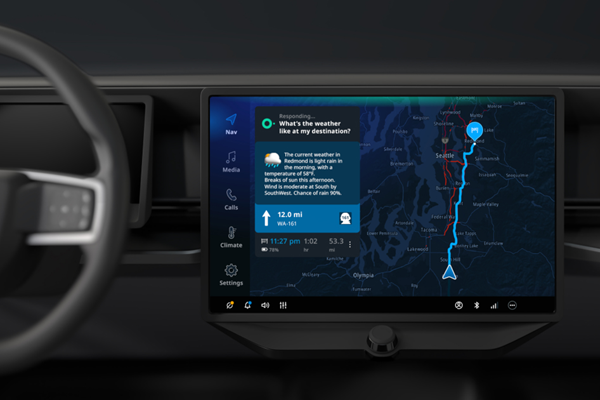Microsoft and TomTom Unveil Generative AI Car Voice Assistant

Navigation tech developer TomTom and Microsoft have collaborated on a new generative AI vehicular voice assistant. The new voice assistant will offer controls for a car’s entertainment, environment, and navigational systems with the natural language abilities of Microsoft Azure’s OpenAI Service, stable of large language models (LLMs). The generative AI model will also enable drivers to request multiple actions all at once without having to reawaken the voice assistant.
TomTom Talk
TomTom is offering its new voice assistant for integration into existing automotive infotainment systems rather than requiring a brand-new vehicle. It also works within TomTom’s Digital Cockpit, an open, modular in-vehicle infotainment platform. Drivers can verbally ask for navigation, find points of interest along their route, control vehicle functions like temperature and radio volume, and more through this single voice interface.
“Together with Microsoft, our shared vision is to drive innovation with generative AI and provide our customers with even better solutions,” TomTom chief revenue officer Mike Schoofs explained. “Leveraging our navigation and technology expertise, we’re creating a groundbreaking new way for people to interact with their vehicles. With both companies integrating what they do best into one solution, we’re transforming the in-vehicle experience, enabling drivers to ask their car for anything and trust it will deliver.”
TomTom and Microsoft have partnered on projects since 2016, when TomTom’s technology was used to support the Azure Maps location services. Microsoft’s first-party maps now all use TomTom’s mapping data and services. The current initiative marks a natural progression of their relationship, according to the companies. They now plan on continuing to expand their work centered on generative AI-powered automotive solutions and the development of a cloud-based digital cockpit and infotainment solution.
There’s a rapidly growing place for generative AI in automotive settings. Mercedes-Benz has also teamed with Microsoft Azure to enhance its voice assistant with generative AI, while Cerence just debuted its own Nvidia-powered generative AI voice assistant. Meanwhile, GM has been experimenting with what Google Cloud can bring to the table in terms of conversational generative AI, and SoundHound has been developing its own generative AI voice assistant for cars all year.
“With this next generation of AI, we have a unique opportunity to accelerate innovation across the entire automotive sector,” said Microsoft corporate vice president for manufacturing and mobility Dominik Wee. “We’re building on our longstanding collaboration with TomTom and bringing together AI advances across the Microsoft Cloud with TomTom’s automotive expertise to provide drivers and carmakers with new AI-powered tools. This integration will enable OEMs to offer highly differentiated and unique cockpit experiences, while preserving their unique brand identity.”
Follow @voicebotaiFollow @erichschwartz
Cerence and Nvidia Debut Automotive Large Language Model CaLLM to Power New Generative AI Features
SoundHound Turns Car Manuals into Voice Assistants With Generative AI
Mercedes-Benz Experiments With Adding ChatGPT to Car Voice Assistant MBUX








